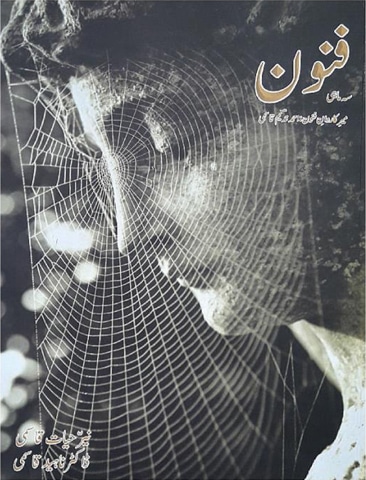
RECENTLY someone asked me whether Urdu’s literary magazines were still in print or had succumbed to the onslaught unleashed by electronic media. The answer was: “yes, they are still published, though nowhere near their past glory”.
The glory in which Urdu’s literary magazines used to bask in is long gone. The sun had been shining brightly over Urdu’s literary journalism since 1940s and 1950s, but began to set in 1990s. In the next two decades, many awe-inspiring periodicals, such as Muhammad Tufail’s Nuqoosh and Vazeer Agha’s Auraaq joined the list that says, in military lingo, ‘missing, probably dead’. Many others, such as Ahmed Nadeem Qasmi’s Funoon either became highly irregular or lost the charm of high quality contents that the readers were used to.
The 1990s had marked a new trend in Urdu’s literary journalism: literary journals were used as a tool to glorify editor’s little or non-existent literary stature. Unlike past when literary groupings were based on intellectual or ideological differences, new lines were drawn and personal likes and dislikes and/or became the standard instead. Editors of quite a few literary magazines would be invited by their overseas “fans” (read: mostly writers of the same literary group or affluent overseas Pakistanis looking for little fame or celebrity friends, or both). Following issues of the magazines would be filled with editor’s pictures taken with their hosts along with write-ups eulogizing hosts’ “brilliant” children and spouses so “expert” in cooking that the editor could be heard licking his fingers while describing in his so-called “literary travelogue” the dishes prepared for him, like ‘kofta’ and ‘karela qeema’. This was indeed a great service to our culinary traditions as well as Urdu literature since Ghalib and Iqbal had never talked of either ‘kofta’ or ‘karela qeema’, what a pity!
Some bigwigs thought it was a good publicity conduit as well as a chance to enhance one’s dubious social reputation and poured money into new literary magazines printed on expensive art paper and full of colours. But genuine readers were used to read high quality magazines like Nuqoosh, albeit printed on cheap newsprint with mediocre printing standards and a rare lustrous title. So avid readers steered clear of new pseudo-literary journals and these magazines soon died an untimely death (or should we say timely?)
Though this arrangement to support the members of ‘Real Mutual Admiration Society’ (a huge community, really) is still going on, social media has taken all glare of glory from Urdu’s literary magazines and many of them are barely surviving: a couple of hundred copies printed usually do not sell and a few readers remit the annual subscription. Fewer can be seen at some designated bookshops.
For example, in Karachi’s Urdu Bazaar, Fazlee Book Shop displays a few of them. Otherwise you can hardly buy any literary magazine at a bookshop in a city like Karachi. Most copies are complimentarily sent through mail and it is the editor or a few friends who bear all the expenses.
So, one has to praise those who sacrifice their valuable time, money and efforts to bring out a literary Urdu magazine these days. One feels like mentioning all those journals here in detail, but only a handful of them could be named here for want of space:
From Lahore, Ahmed Nadeem Qasmi’s famed literary magazine Funoon has brought out a thick ‘Special Issue-2021’. Under the editorship of Nayyar Hayat Qasmi and Naheed Qasmi, the issue offers some fresh writings by some of today’s bigwigs. From Karachi, Iqbal Nazar has been editing and publishing Collage. The recent issue has some good writings, of them the most absorbing, perhaps, is Muneer Niazi’s pen-sketch by Asgher Nadeem Syed. It successfully captures the real personality of Muneer Niazi, the eccentric poet.
Zeest is a literary magazine edited by Dr Ansaar Ahmed. Published from Karachi, its Jan-June 2021 issue, a thick one, proffers many creative works both in prose and poetry. Insha is edited and published by Safdar Ali Khan from Karachi.
He has been bringing it out for the last 28 years, but has received little or no acknowledgement. The recent issue (July-Dec 2021) includes critical and creative writings. Another Karachi-based literary journal about to complete a quarter of a century of its publication is Lauh-i-Adab. Shakeel Ahmed Khan is the editor.
Interestingly, when the survival of quarterlies and yearly journals is becoming increasingly difficult, Mubeen Mirza decided to turn his bi-annual Mukalma into a monthly. And he has been running it successfully. In fact, it is one of the most popular literary magazines today.
How monthlies survive in this slack literary market can be puzzling but at least three other monthlies are braving the elements: Qaumi Zaban, Karachi; Akhbar-i-Urdu, Islamabad and Al-Hamra, Lahore. Al-Hamra is being published regularly without any governmental support.
Published in Dawn, January 24th, 2022












































Dear visitor, the comments section is undergoing an overhaul and will return soon.